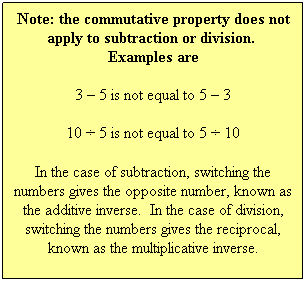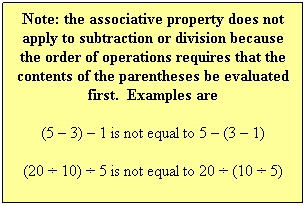The Properties of The Real
Numbers
The following properties
are true for any real numbers a, b, and
c.
I. The Computational Properties:
Commutative, Associative, Distributive, Identity.
|
1. The Commutative Property
of Addition. "Commutative " means that something moves back and
forth, as in "commuting" to work. The commutative property of addition
allows the order of addition to be changed. 3 + 5 = 5 + 3
We know that both expressions equal 8.
In more formal language,
If
a and b are two real numbers,
then a + b = b + a. |
 |
2. The Commutative Property
of Multiplication.
The commutative property of multiplication allows
the order of addition to be changed.
3 × 5 = 5 × 3
We know that both expressions equal 15.
In more formal language,
If a and b are two real numbers, then ab = ba.
|
3. The Associative
Property of Addition.
"Associative" refers to association or grouping.
In arithmetic, grouping is done with parentheses. So, this property
allows that under certain circumstances, that is, in a series of terms
that are being added, grouping can be changed.
(3 + 5) + 7 = 3 + (5 + 7)
|
 |
In more formal language,
If a, b, and c are
three real numbers, then (a + b) + c = a + (b + c).
4. The Associative Property
of Multiplication.
This property allows that in a series of terms that
are being multiplied, grouping can be changed.
(3 × 5) × 7 = 3 × (5 ×
7)
In more formal language,
If a, b, and c are
three real numbers, then (ab)c = a(bc).
5. The Distributive
Property. This may be the most important of the properties because
it leads to our notions of "combining like terms" and "factoring."
If a, b, and c are three real
numbers, then
a(b + c) = ab + bc
and (b + c)a = ba + ca
also,
a(b – c) = ab – bc
and (b – c)a = ba – ca
Because a,
b,
and c, are real numbers, they can be variables or specific numbers
and the property holds true.
6. Identity Properties.
Identities
are numbers that when used in an operation give an answer that is identical
to what we started with.
Addition has as its identity
element the number zero because any number a added with zero gives
a
as the result:
a + 0 =
a
This is the Identity Property
of Addition.
Multiplication has as its
identity element the number one because any number a multiplied
with one gives a as the result:
a ·1 =
a
This is the Identity Property of Multiplication.
7. The Multiplicative
Property of Zero. Any number a multiplied with zero give zero
as its result.
a ·0 = 0 ·a =
0
This property is important because we use it to
solve equations that can be factored.
8. The Substitution Property.
If
a = b, then a may be substituted for b and vice versa.
This is, perhaps, the most used property in all
of mathematics. We use whenever we evaluate an expression or perform
an operation.
II. The Properties
of Equality and Inequality.
1. The Reflexive Property. If a is a real number, then a = a.
This may seem obvious (and it should!), but this statement is important
because it means that each number can have only one value (although
that value can be expressed in different ways). If a = 1/2,
then a cannot have any other value! It cannot also equal 3
or -6.7 or something else. Note, a can be expressed as 0.5,
for that has the same
value (or amount) as 1/2.
2. The Symmetric Property. If a
and b are two real numbers and
a = b, then
b = a.
This says that we can turn an equation around and the equation is still
the same.
3. The Transitive
Property. If
a,
b, and c are real numbers, and
further, if a = b and
b = c, then a = c.
This is a consequence of the substitution property (can you see why?).
The following five properties
lie at the heart of our equation solving techniques.
4. The Addition Property
of Equality. If
a,
b, and c are real numbers,
and a = b, then
a + c = b + c. The idea is this:
if two quantities are equal (as in the case of a balance beam with equal
weights on it), then adding the same to both sides keeps things equal.
5. The Subtraction
Property of Equality.
If
a, b, and c are real
numbers, and a = b, then
a – c = b – c. The idea is
this: if two quantities are equal (as in the case of a balance beam
with equal weights on it), then subtracting the same to both sides keeps
things equal.
6. The Multiplication
Property of Equality.
If
a, b, and c are real
numbers, and a = b, then a × c = b × c.
The idea is this: if two quantities are equal (as in the case of
a balance beam with equal weights on it), then multiplying both sides by
the same amount keeps things equal.
7. The Division Property of Equality.
If
a,
b, and c are real numbers, and a = b, then
a ÷
c = b ÷ c. The idea is this: if two quantities are
equal (as in the case of a balance beam with equal weights on it), then
dividing both sides by the same amount keeps things equal.
8. The Function Property of Equality.
If
a,
and
b are real numbers, and a = b, then
f(a)
= f(b) provided the function is defined for both a and
b.
This is not an official algebraic property, but it embodies the idea that
"what we do on one side of the equation, we must do on the other side of
the equation to maintain equality. This is the core of how we solve
problems like x 3 = 125: we take the cube root of both
sides.
III. The Closure
Property and the System of Real Numbers.
1. If any two numbers
in a set are operated on by some operation, and the result is always a
number in that set, then the set is said to be closed under that
operation. This is called the Closure Property.
This means that if we study an operation,
say addition, then if we add any two numbers from a larger set of numbers,
say, the integers, and the answer itself is always an integer, then we
say that the integers are closed under the operation of addition.
Note: this property is about sets of numbers as much as it
is about operations.
2. Number Sets

This diagram illustrates the relationships between
the sets of numbers in the Real Number System. It is important to
know that a Whole Number, for example, is also an Integer and is
also a Rational Number and a Real Number at the same time!
Thus, the rectangles above show that numbers that are in a certain subset
of the real numbers are automatically in other subsets at the same time.
|
a. The Natural numbers
are the “counting numbers”, that is 1, 2, 3, 4, …
b. The Whole numbers are the
Natural numbers plus the element 0. They are 0, 1, 2, 3, …
c. The Integers are defined as any
rational number whose denominator is 1. They are …, -2, -1, 0, 1,
2, … When we draw number lines, we usually label the integers.
d. The Rational numbers are any
numbers that can be written as a fraction of two integers. Examples
are -3/4, 0.35, 5, and 1,000.
e. The Irrational numbers are any
numbers that
cannot be written as a fraction of two integers.
The most famous example is  .
Other examples are
.
Other examples are  and e = 2.718281828… Any square root of a number that is
not a perfect square is irrational. Similarly, any cube root
of a number that is not a perfect cube is irrational (and so on).
and e = 2.718281828… Any square root of a number that is
not a perfect square is irrational. Similarly, any cube root
of a number that is not a perfect cube is irrational (and so on).
f. No number is both Irrational and Rational
at the same time.
g. The Real numbers are all of
the Rationals and all of the Irrationals taken together. Every real
number is either rational or irrational. The number line is a picture
of the entire real number system.
3. Examples.
The Integers are closed under the operation
of addition because every time you add two integers, the result is an integer.
The Whole numbers are closed under the operation
of multiplication because every time you multiply two whole numbers, the
result is a whole number.
The Natural numbers are not closed under
the operation of subtraction. A counterexample is 4 –
9
= -5. We subtracted 9 from 4 (both are natural numbers) and the result
was -5 which is not a natural number.


